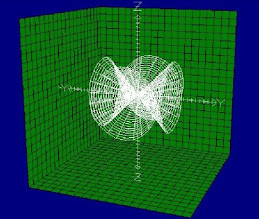One of those geometrical impossibilities which many people know of, is the division of an arbitrary angle by 3, with only a compass and an unmarked ruler. My advice is: don't try it using the geometry you learned at school, you'll be caught in a dead end. Of course, you might try it for some time to get experience with it, experiencing by yourself the hopes and frustrations that generations of mathematical inquirers have felt, but don't expect to break through in this way. In order to bypass the impossibility, you need to step back and try it differently. That's how inquiring minds discovered physical tools or paper folding manners that allow to trisect an angle.
Another way to explore trisection is to reformulate the problem. Dividing an angle is the inverse operation of multiplying an angle. So, if we want to solve problems involving the trisection of an angle, we might first focus on solutions to the problem of tripling an angle. This may sound trivial, so trivial that hardly anyone emphasizes this point. Before learning the operation of division, we should first learn how to multiply. Through multiplication, we advance constructively from a unit towards a product of factors. Once we know how we got that product through multiplication, we can divide backwards the product through factorization.
Multiplying geometrically means generating one length (or surface or volume) from another. If we do this recursively, we get a series of successive powers. For example, with straight lines, using the Thales intercept theorem, we can mark successive powers of a number on lines, see Figure 1. If OA'/OA = x and OA is our unit length and OA' = OB, than you can verify that OB = x, OC = x2, OD = x3, OE = x4, etc.
So forwards, we multiply each time by x. If we go backwards in the series we divide each time by x and we needn't stop at our initial unit length, but we may divide indefinitely and recursively by x. So the geometric representation of multiplication gives us insight on how to divide an initial length OA by x.
We can do something similar with circular arc lengths. For example, for the recursive doubling of an arc, we can proceed as illustrated in Figure 2.
- Define a unit arc from an origin O on a circle of center P. Draw also a little circle of diameter OP.
- If from the endpoint 1 of the unit arc, we draw a radius towards P, it intersects the little circle at the (red) point illustrated on the figure. If we double the (red) chord from O to that (red) point, it will end up at length 2 on the large circle.
- If from the (red) endpoint 2 of the arc, we draw the (red) radius towards P, it intersects the little circle at the (blue) point illustrated on the figure. If we double the (blue) chord from O to that (blue) point, it will end up at at length 2*2=4 on the large circle.
- Proceeding further (blue, green, violet...) in the same manner will mark successive powers of 2 on the large circle (as well on the small circle).
If we reverse the direction of this recurrence, we can halve the length of the arc indefinitely. The proof of this recurrence can be given using the isosceles triangles, two sides of which are successive chords.
Update 19 November 2016: the conjectured process below is incorrect. This is not the correct way to multiply angles. It only works for doubling and quadrupling angles (may other powers of 2, I didn't check).
By adapting the geometric configuration of the two circles, we can do the same for the multiplication of an arc by any integer number, forwards. There is no impossibility to multiply an angle by an integer. Reversing the direction of the recurrence, it becomes therefore possible to access to the division of an arc by any integer number, and henceforth any rational number. As food for thought, the beginning of the conjectured process is illustrated in Figure 3.
Update 19 November 2016: the conjectured process below is incorrect. This is not the correct way to multiply angles. It only works for doubling and quadrupling angles (may other powers of 2, I didn't check).
By adapting the geometric configuration of the two circles, we can do the same for the multiplication of an arc by any integer number, forwards. There is no impossibility to multiply an angle by an integer. Reversing the direction of the recurrence, it becomes therefore possible to access to the division of an arc by any integer number, and henceforth any rational number. As food for thought, the beginning of the conjectured process is illustrated in Figure 3.
- Draw a circle of diameter QP.
- A circle of center P and with radius smaller than QP defines the origin of the arc at one of their intersections O.
- Define a unit arc from origin O on the circle of center P.
- If from endpoint 1 of the unit arc, we draw a radius towards P, it intersects the other circle at the (red) point illustrated on the figure. If we prolongate the (red) chord from Q to the (red) point, it will end up at length x on the arc.
- If from (red) endpoint x of the arc, we draw the (red) radius towards P, it intersects the other circle at the (blue) point illustrated on the figure. If we prolongate the (blue) chord from Q to that (blue) point, it will end up at length x*x=x2 on the arc.
- Proceeding further (blue, green...) in the same manner will mark successive powers of x on the circle.





